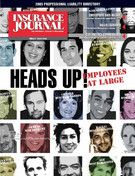Insurers must not be lulled into thinking that the Directors and Officers liability market has recovered because the quantity of cases remain high and the complexities of litigation are overwhelming.
As a result, carriers are going to have to work harder to get the capacity they need and that will ultimately have an impact on price, the PLUS 17th Annual International Conference attendees were told.
“Many people are of the belief that rates have been heavy, overpriced and should come down. That would be a nice thing to believe, but that is counter intuitive and counter productive,” said Anthony S. Galban, senior vice president, Global D&O product manager, Chubb & Son. “We talk about capitalization and paper quality, but the other part of the equation is underwriting discipline,” he said. “You have to be willing to stick with strict underwriting and not succumb to market pressures. You have to avoid the rationalization to ease up on rates or you will rationalize yourself into an unprofitable state.”
Galban noted that an insurer has to be willing to let risky business go. “In order to be disciplined, you have to be willing to let risks go when they become too risky,” he said.
Peter McKeegan, senior vice president, ARCH Insurance Group, noted that there were 20 $100 million settlements in 2004. “It doesn’t take much to do the math. If the primary prices are collapsing and excess line is following suit, you’re going to have a problem,” he said.
Greg Flood, EVP and COO, National Union Fire Insurance Company, said that the factual evidence hits home. “The quantity of cases hasn’t diminished. The complexities of the litigation are overwhelming. Today you have so many pieces that have to be managed. You have pension funds, derivatives, and industry wildcatting. In 2001 we saw the industry wildcatting. That was followed by stock funds, mutual funds and, sad to say, the insurance industry.”
“There’s no logic to where the market is,” added Jim Nestheide, vice president, St. Paul Travelers. “All we are doing is putting ourselves right back into the position we were in five years ago. We’re the ones paying the losses; it’s not slowing down at all.”
Looking at reserve issues, James M. Fasone, senior vice president, Gallagher Healthcare, questioned whether there is a capability to pay a backlog of claims. “If you look at the reserve adequacy, there are significant challenges for the industry going forward. “We’ve had $47 billion in reserve charges over past three years, $67 billion in reserve deficiencies.”
Flood noted that primary characters have a chance to get the reserves right. “Aside from the fact that reserves are difficult to peg, there is also difficulty in getting reinsurance recoveries. Some reinsurers haven’t quite fixed their problems.”
Nestheide recommended that insurers work with primary carriers to see how bad it will be. “It is complicated, it depends who is underneath you and how information is shared,” he said. “We hear about carriers that are new to the game and that don’t have legacy issues. They don’t have a luxury of seven years for it to resolve itself.”
“When you’re looking at reserves and what carriers are posting on their line by line reserves and if you see them at 40 or 50 percent, there’s something to be concerned about,” said McKeegan. “All of a sudden you’re going to get hit.”
Fasone, who moderated the panel, noted that there are a record number of insurers in runoff and a lot of capacity issues, and asked the panel about their perspective on reinsurance and its impact on rates.
Nestheide reported that he met with 10 reinsurers that are all very concerned about public D&O. “They are interested in carriers that have an edge and understand the line of business. The sentiment is they don’t think you can make money in this business. There are a record number of reinsurers in runoff,” explained Nestheide. “There are reinsurance recoverables and capacity restraints.”
Nestheide predicted that upcoming renewal structures will change.
“It will be very interesting to see whether there will be enough capacity, but there will be restrictions,”he said. “Those in the market who buy reinsurance will find it difficult to do business. Half the capacity is reinsured. A lot of insurers are going to have to deal with this issue.”
He further noted that for the first time reinsurers are now interested in fiduciary liability. “If you are a publicly-traded D&O market, it will be more difficult. All the carriers are going to have to work harder to get the capacity they need and that will have an impact on price. Insurers will have to do some things they don’t want to do based on capacity,” Nestheide continued.
Looking at underwriting fraud, McKeegan noted in a recent poll that 43 percent of insurers stated that dishonesty was a main issue facing the securities industry. “Fifty-one percent of investors have ‘just a little’ or ‘not very much’ confidence that securities industry reforms will reduce abuses,” he said. “We have to underwrite smarter.”
Flood noted that the information you give to an underwriter is important. “I want to understand what the real risk is. There has been no fundamental shift in the restatements since the introduction of the Sarbanes-Oxley Act.”
Nestheide added that since Sarbanes-Oxley, “I tell underwriters it is what you don’t say that is really important.”
“Consultants are having a field day,” said McKeegan. “They’re laying out all these methodologies for testing, etc., so nothing can ever go wrong with our company. But things happen in life. CEOs, especially in large corporations, can’t take care of everything. They don’t always have control in place. If you say you’re in compliance and you’re not, you lied.”
Flood noted that there is new enthusiasm by regulators. “They’re growing their own staff. Rates are going to be affected by enforcement, including wildcatting. They have the additional resources.”
Galban said that regulators are empowered and capitalized. “We need to pay attention to the risk factors. There is a new area of loss control that we need to be attentive to. Outcomes have a lot to do with the first exchange and the cooperation regulators get. A lot of companies don’t know what to do when regulators call.”
Galban explained that insurers live in an environment that has less to do with liability and more to do with money.
“We realize that the way we manage risk selection and other facets is not necessary about legal theories. It’s about money. It’s about charging premiums. Settlements happen quickly. Pricing is based on simple economic exchanges. The business has become even more brazen than it ever was before with money rather than liability.”
Looking at insurer solvency, Fasone noted that traditionally securities cases on average take around three years to settle. “Most D&O policies are written for one year. Some special purpose D&O policies run up to six years,” he said. “An insured with a claim on average has a four-year minimum counter party exposure to the insurer: a one-year policy plus three years to settle.”
Some claims have taken up to eight years to settle or work through a judgment.
Flood noted that companies have to take more responsibility to see who they are buying from. “In this business we’ve never paid much attention to the purchasing cycle,” he said.
Nestheide noted that there is always some pressure with a slow month or quarter.
“When there is pressure to get the number, the underwriting discipline goes away. You can almost see it in the marketplace–which companies have top line pressure,” he said.
“You don’t want to give up your renewals if they are priced right,” McKeegan said, “but if they’re priced wrong, you don’t want to keep doing it.”
“At the end of the day, credibility is what matters,” said Fasone. “We are our own worst enemy. If we don’t discipline properly, then we are destined to repeat what we say can’t happen.”
Nestheide said that he thought companies have better measurements than they did 10 years ago. “We have a lot of predictive modeling going on. The metrics are better. It gives me a little more comfort that we are getting closer,” he said.
“If you look at the size of the market today and the 12 more critical players, at least six don’t have the actuarial background to post their own results,” said Flood. “Going into 2005, a lot of companies that came in after 9/11 know the consequences that will happen to them.”
Topics Carriers Flood Underwriting Reinsurance
Was this article valuable?
Here are more articles you may enjoy.


 Insurance Industry ‘Megadeals’ Dominate 2025, Says PwC
Insurance Industry ‘Megadeals’ Dominate 2025, Says PwC  Aon Adds to List of Brokers Suing Howden US for Alleged Poaching, Theft
Aon Adds to List of Brokers Suing Howden US for Alleged Poaching, Theft  Hyundai, Kia Agree to Retrofit 7 Million Vehicles to Address Theft Concerns
Hyundai, Kia Agree to Retrofit 7 Million Vehicles to Address Theft Concerns  Florida Jury Returns $779M Verdict for Family of Security Guard Killed at Gambling Cafe
Florida Jury Returns $779M Verdict for Family of Security Guard Killed at Gambling Cafe 


